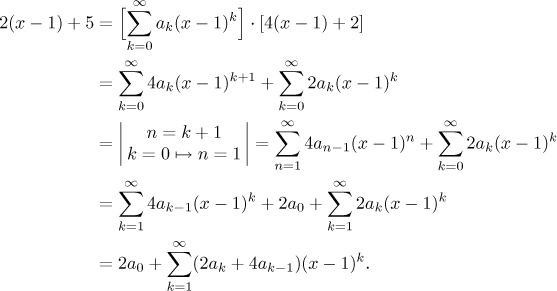Problem: Expand the given function in a power (Taylor) series with the given center:
![]()
Solution:
We use the
standard approach. What function
will be the basic one to expand? There is no exponential, sine or cosine, so
by elimination it is either the geometric expansion or some more advanced
trick. Can we make it look like (roughly) the function
![]()
Now we follow the standard procedure to create
![]()
Now we are ready to expand this fraction using the geometric series, here we
have to be careful about validity of that expansion. Then we rearrange the
resulting series so that the terms

Note that the fraction

Bonus: The given function is actually a ratio of two functions that
we know how to expand in power series, therefore we can try to expand this
ratio using the method of undetermined coefficients. We write the numerator
and denominator as series, which is quite simple. These are polynomials and
thus we simply rewrite them to a form that features terms

Now we multiply both sides by the denominator in order to get rid of the fraction and then rewrite the resulting series on the right into one series. Fortunately we do not need to use the Cauchy product there, since one of the two series is "finite", it has only finitely many non-zero terms.

On the third line we shifted indexing in the first series to get the right power, then we had to take away the first term in the second series so that the two series on the right have the same indexing.
We obtained equality of two series, so by uniqueness of expansion the corresponding coefficients on the left and on the right must be the same.

Using the last formula we recursively obtain